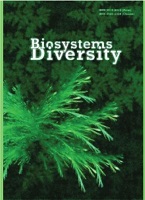Antifungal activity of the endophytic Aspergillus against Candida albicans
Antifungal activity of the endophytic Aspergillus against Candida albicans
Author(s): H. S. Nacef, A. Bouguerra, R. BelhattabSubject(s): Health and medicine and law, Environmental interactions
Published by: Дніпропетровський національний університет імені Олеся Гончара
Keywords: : Aspergillus; bioactive molecules; Candida albicans; endophyte; extraction; medicinal plants;
Summary/Abstract: Medicinal plants remain a reliable source of bioactive compound principles known for their proven therapeutic abilities against various infectious diseases. Endophytes, microorganisms residing within plant tissues, hold promise for producing novel metabolites with potential medical applications. This study analyzes the antagonism of endophytic fungi Aspergillussp., isolated from medicinal plants, and their extract against Candida albicans, and their effectiveness was compared with that of a medical treatment, Phanazol 1% ointment. After isolating, purifying, and identifying endophytic fungi from the medicinal plants Lavandula officinalis, Rosmarinus officinalis, Eucalyptus bicolor and Mentha piprita, a total of ten endophytic fungi were obtained. These included two yeasts (yeast and Rhodotorula sp.), as well as eight moulds (Aspergillussp., Aspergillus niger, Nigrospora sp., Curvularia sp., Alternaria sp., Penicillium sp.), and sterile mycelium. Allthese fungi were tested for their antagonism against C. albicans; using the cross-streak and disk diffusion methods for yeasts and moulds respectively, with the measurement of the diameter of the growth inhibition zone of the culture. Only the strain Aspergillussp. and its ethyl acetate extract exhibited good activity against C. albicans, with inhibition zone widths of 27.5 and 20.3 mm, respectively. Its effectiveness is comparable to that of Phanazol 1% ointment. The use of gas chromatography mass spectrometry (GC/MS) unveiled the metabolite profiles of Aspergillus sp., enabling the recognition of 10 bioactive compounds, with butanedioic acid, kojic acid, and Cyclo L-prolyl-L-valine being the major ones, constituting 45.1%, 23.1%, and 5.1% of the total, respectively. These compounds serve as valuable platform chemicals that can be transformed into various other useful chemicals with various applications in agriculture, pharmaceuticals, food, cosmetics, and the healthcare industry. In addition to refining the active substances within this extract, it has the potential to open doors for creating novel biosourced medications aimed at addressing resistant opportunistic fungal or bacterial infections.
Journal: Biosystems Diversity
- Issue Year: 31/2023
- Issue No: 3
- Page Range: 388-392
- Page Count: 6
- Language: English

